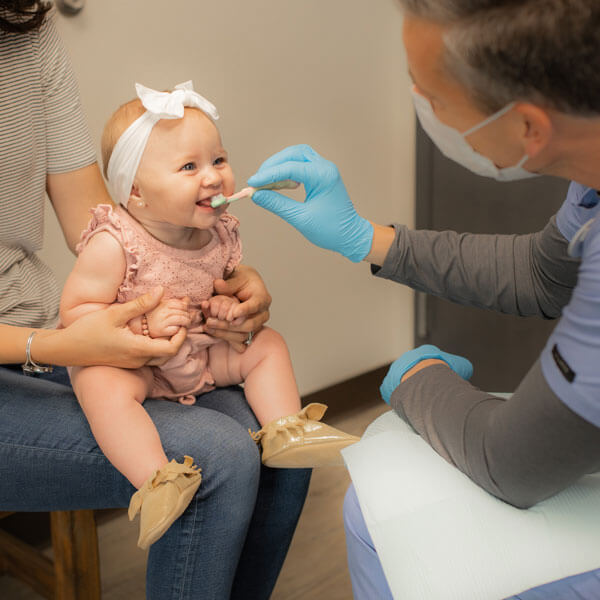Frenectomies
Help your little surfer shine to their full potential!

Frenectomies Support Healthy Development
If your child is facing challenges related to speech, feeding, or orthodontic concerns, a frenectomy might be recommended. The frenulum is normal tissue that connects the tongue to the floor of the mouth and the lips to the gums. Unfortunately, this tissue may be restrictive and prevent normal function. A frenectomy involves adjusting this tissue to improve function. Without this procedure, improper development of the palate can occur, potentially leading to sleep issues or breathing difficulties.
There are two primary reasons why your little one might benefit from a frenectomy:
- Tongue Tie: Some children are born with a shortened frenulum under the tongue, limiting movement. This can make breastfeeding difficult and may interfere with the ability to form certain sounds.
- Lip Tie: A shortened frenulum of the upper or lower lip restricts normal movement, making breastfeeding challenging. It can also cause aesthetic concerns that complicate orthodontic treatment.
A Collaborative Approach
Managing tethered tissues often requires a comprehensive team approach to ensure all related concerns are properly addressed. This multidisciplinary team may include:
- Your Pediatrician
- Your Body Adjuster (Chiropractor or Craniosacral Therapist)
- Your Lactation Consultant
- Myofunctional Therapist
Lasers Offer a Less-Invasive Solution for Your Kiddo’s Needs!
Why We Use Lasers for Frenectomies
We understand that every parent will appreciate the benefits of laser surgery compared to traditional methods using scissors or scalpels:
- Less Bleeding: As it ablates tissue, the CO2 laser seals small blood vessels. This reduces bleeding and preserves good visualization of the treatment area.
- Less Swelling: The laser does not tear or bruise the tissue. This is because the tissues in contacted only by the laser’s light. Reduced trauma to the tissue results in less post-operative swelling.
- Less Discomfort: Minimized swelling means less pressure on the surrounding tissues, diminishing the risk of post-operative discomfort.
- Less Infection Risk: The laser’s hight intensity light destroys surface bacteria, producing a sanitizing effect.
- Less Invasive: The lightweight ergonomic handpiece and flexible fiber of the LightScalpel® laser allows for enhanced precision and accuracy.
- Less Time: Because the LightScalpel® laser produces less bleeding, the surgical team spends less time maintaining a dry surgical site.
Fortunately, the Smile Surfers team can perform a quick and straightforward frenectomy to address issues caused by a tongue or lip tie. Our pediatric dentists use a CO2 laser to safely and efficiently release the shortened frenulum.

Why Choose Smile Surfers for a Frenectomy?
Because You and Your Children Deserve the Best Care!
When it comes to your little surfers, you want to ensure their healthcare is in the best hands. At Smile Surfers, we specialize in caring for kids! We understand their unique needs and prioritize creating a safe and secure environment during treatment. Our team is skilled at building trust and forming lasting personal relationships with your child.
Our pediatric dentists in Moses Lake have undergone specialized training to provide effective and comfortable treatment for tethered oral issues.
Get the Answers.
Frenectomy F.A.Q.
How can a tongue or lip tie affect breastfeeding?
Shortened frenula can make it challenging for babies to nurse effectively, as they may struggle to maintain a secure latch on the breast. This can lead to poor weight gain or cause the infant to suck in and swallow excessive air, resulting in colic, reflux, or spitting up.
In an attempt to latch on correctly, an infant may try to “gum” the breast, which can be extremely painful for the mother and may result in plugged milk ducts, blistered and sore nipples, and mastitis. A lactation consultant can often identify the early signs of a tongue or lip tie and determine if it’s an issue that needs to be addressed by a pediatric dentist. The sooner you consult with our doctors, the better. It’s common to see newborns as early as two to five days old.
What is recovery like after a frenectomy?
Typically, it takes about 14 to 21 days to fully heal from a laser frenectomy. The first few days are crucial, so we will want to see you 3 to 5 days after the procedure. During this time, the patient should rest and allow the healing process to unfold. For infants, breastfeeding right after the procedure is encouraged, as breast milk has healing properties, and the act of breastfeeding can provide comfort and reassurance to the baby.
If you’re worried about post-operative pain, your pediatric dentist can help you select appropriate over-the-counter medications for pain management. Usually, no medication is needed, especially if breastfeeding. Following the post-procedure tissue stretch instructions is essential for proper healing and to maximize the benefits of the treatment.